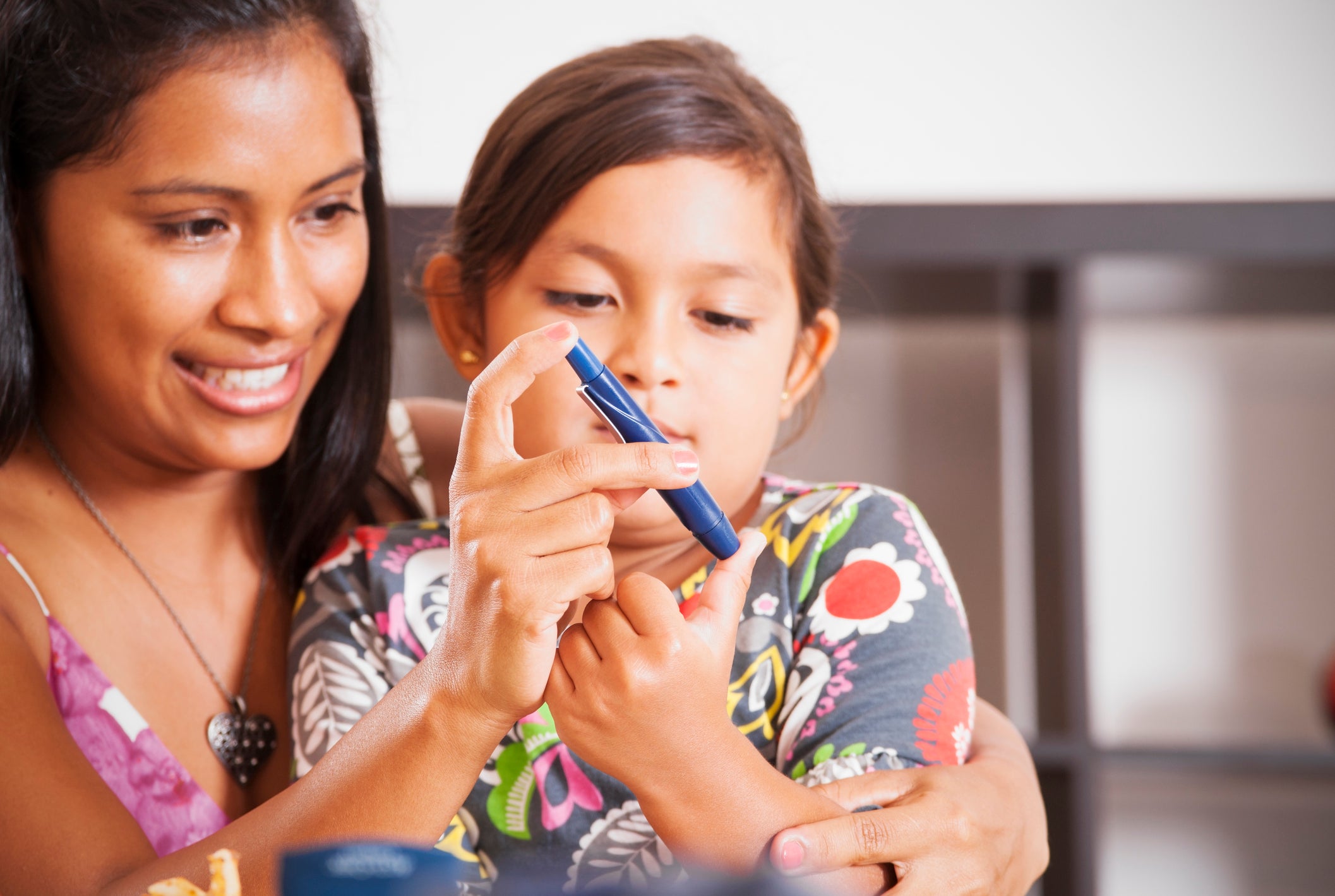Q and A on Pediatric Diabetes with Dr. Hillary Lockemer
November 28, 2023
By: WakeMed Children's Hospital
Categories: diseases & conditions, Primary Care, Children's
Incidents of diabetes are growing in children.
According to the American Diabetes Association, “About 283,000 Americans under age 20 are estimated to have diagnosed diabetes, approximately 0.35% of that population. In 2014–2015, the annual incidence of diagnosed diabetes in youth was estimated at 18,200 with type 1 diabetes, 5,800 with type 2 diabetes.”
Both type 1 and type 2 diabetes can gravely impact a child’s health if left untreated, but with treatment, there is hope for a normal and happy life.
We sat down with Hillary Lockemer, MD, FAAP, a pediatric endocrinologist and the current medical director of WakeMed Children’s – Pediatric Endocrinology to learn all about this condition and how it is treated.
Tell me about your journey to becoming a pediatric endocrinologist.
I have been in practice for 11 years following three years of pediatric residency and three years of pediatric endocrinology fellowship training. In all, I’ve worked closer to 14 years with patients with diabetes. I knew I wanted to go into pediatrics by the time I was 13 because I’ve always loved working with kids. I got really interested in endocrinology when I took an endocrinology class in college. The professor was dynamic while speaking of the different medical conditions. The subject made a lot of sense to me, and each time I worked with pediatric endocrinology patients, the experience reinforced this was the right specialty for me.
I get to know my patients really well. I see them more often than their pediatrician, and I watch them grow, mature and evolve right before my eyes. I love getting to know about their interests in sports and other activities. They’ll share pictures with me, and I really love building these long-term relationships with patients and families.
Most of my work is in the clinic, but I do go into the hospital, so I get that balance. And, while a lot of patients with diabetes are very sick when they first get diagnosed, and it is a potentially life-threatening disease, we can get the disease under control very quickly. In fact, nearly every condition in endocrinolgy can be treated with medication, so it’s a pretty positive field to be in.
Why is diabetes treated by an endocrinologist?

An endocrinologist is a hormone doctor. Insulin is a hormone, and it basically helps our bodies use glucose from the food as an energy source for our cells. In diabetes, either the body isn’t making insulin, or it isn’t responding to it very well. The underlying issue is a hormone problem. That’s why an endocrinologist manages diabetes.
What are type 1 and type 2 diabetes and how do they differ?
Type 1 diabetes is an autoimmune condition. That means the immune system, which normally fights off infection, has decided to attack the cells that make insulin. Those cells are located in a gland called the pancreas. Certain genes make it more likely to develop diabetes, but not everyone who has those genes goes on to develop the disease.
Type 1 diabetes is the most common type we see in kids and teenagers. We absolutely see it in adults as well, but it is more commonly diagnosed in childhood and adolescence.
In type 1 diabetes, the pancreas isn’t making insulin at all. People start to have symptoms when about 80 to 90 percent of the pancreas is no longer making insulin. It is a state of insulin deficiency. Individuals with type 1 diabetes have to have insulin because they have to replace what the body is no longer making.
Type 2 diabetes is a little more complex. In some cases, type 2 diabetes can be genetic, running in families. The hallmark of type 2 diabetes is insulin resistance. Initially, the pancreas is making insulin, but it just doesn’t respond to it as well. Some gene mutations cause the body to stop making insulin or responding to it as well. We’re identifying more and more of those genes. Insulin resistance can also be due to dietary and lifestyle choices. Being overweight and sedentary can lead to diabetes. They can affect the body’s insulin resistance and can make it even harder for the body to really respond to insulin.
Some individuals with type 2 diabetes burn out their pancreas. It works so hard that it can stop making insulin. These patients may require insulin just as someone with type 1 diabetes.
What causes diabetes?
Type 1 diabetes is complicated. We don’t know why it happens. In people who are genetically predisposed, we believe they are “hit” with something, such as a virus or environmental factor. The double whammy causes the immune system to go haywire, resulting in decreased insulin production.
For Type 2 diabetes, we find evidence of gene mutations that impact how insulin is made along with lifestyle challenges.
What are the signs and symptoms of type 1 disease?
Type 1 Diabetes
- Increased thirst
- Increased urination
- Rapid weight loss
Those symptoms typically occur within a few weeks of being diagnosed with diabetes because blood sugars are really high, or there is insufficient insulin to use the glucose or blood sugars for energy. Basically glucose gets trapped in the blood, the body recognizes it and the kidneys pee out the extra glucose. This creates a dominoe effect because as people urinate more, they become dehydrated, increasing thirst. Parents may not realize that increased thirst is because of increased urination, especially in the south where it becomes hot and humid.
I tell parents if a child cannot make it through a 90-minute family movie without urinating two or three times, this is a red flag. Other symptoms include a child suddenly beginning to get up throughout the night to go to the bathroom or beginning to wet the bed. In these situations, the child, including teens, cannot control the increased urine output because the body is desperately trying to eliminate extra glucose levels.
Are the symptoms of type 2 diabetes the same?
If blood sugars get high enough, children can experience the symptoms of type 1 diabetes. However, early on, there usually are not many symptoms. For type 2 diabetes, it is much more common for us to meet patients with higher blood sugars, sometimes for months, and no one realized it.
More common clues of type 2 diabetes are the following:
- Fatigue
- Vision changes or blurry vision
High blood glucose levels translate to the body not processing glucose as energy, causing fatigue. Higher blood sugars lead to more concentrated fluid throughout the body, including around the eyes, manifesting as changed or blurry vision.
Is type 1 or type 2 diabetes preventable?
Type 1 diabetes is not preventable, but we can delay the need for insulin by identifying it years before someone ever needs insulin. We now have more medical therapies and approaches to help delay the body from losing more insulin function.
What we’re hoping is that we can one day take all of the information we have and delay the need for insulin indefinitely, which essentially prevents type 1 diabetes from occurring. A lot of really cool advancements in type 1 diabetes, along with our evolving understanding, make it a great time to be working in this field.
With type 2 diabetes, it’s easier to prevent, but it’s not always preventable. It is a common misconception that a person can completely avoid acquiring type 2 diabetes. Most people associate it with poor lifestyle choices. However, as I mentioned, a lot of families have a strong genetic predisposition to it, so adjusting diet, exercising and maintaining a healthy weight, may help delay the diagnosis, but it may not fully prevent it.
It’s really important, especially when a child or adolescent gets diagnosed with type 2 diabetes, to eliminate the guilt associated with the diagnosis.
Besides insulin, is there any other treatment for type 1 and type 2 diabetes?

For type 1 diabetes, the only treatment is insulin. There are different ways of giving insulin, and it is a lifelong treatment regimen.
For type 2 diabetes, there are numerous options, especially for kids and teenagers. Over the last couple of years, we’ve been fortunate to get many more medications FDA approved. There are now three or four classes of medications for type 2 diabetes. Some are taken orally, and some are injected.
Insulin can also be used in type 2 diabetes. In those patients who have burned out the pancreas, insulin is the option.
Additionally in type 2 diabetes, making changes to diet, activity levels and/or weight may help.
What is an ideal diet for diabetics?
An ideal diet for anybody is a healthy, well-balanced diet. The Mediterranean diet is a great option. Yet, I am all about moderation. I tell my patients, “If you do cake on your birthday, I still want you to do cake on your birthday.” I also caution against sugar-free foods since they are not any better. They still have carbohydrates.
My top recommendation is to cut out sugary drinks. Sports drinks, juices, energy drinks, soda, lemonade and sweet tea are beverages to avoid. Water is always best and should primarily be the drink of choice.
What is low blood sugar, how does a family know if it’s low and is there a treatment for it?
Low blood sugar is less than 70 milligrams per deciliter. Someone with diabetes, with blood sugar below 70, may experience the following symptoms:
- Shakiness
- Jitteriness
- Lightheadedness
- Perspiration
- Dizziness
- Tiredness/fatigue
- Nausea
- Abdominal pain
- Ravenous hunger
If they have any symptoms, we recommend blood sugar checks to see what it is because there are times when symptoms can be deceptive. If the blood sugar is, in fact, less than 70, we teach what’s called the rule of fifteens.
-
Treat with 15 grams of fast-acting carbohydrates. This would look like one of the following:
- Four ounces of regular soda
- Six ounces of juice
- Three hard candies
- After 15 minutes, patients should recheck their blood sugar on a glucometer or continuous glucometer to ensure the blood sugar has moved to above 70.
If a child has high blood sugar and is about to eat, should the meal be avoided?

High blood sugar is above 250. Depending on how high the blood sugar is, we encourage consumption of a lower carbohydrate meal.
Additionally, a correction scale helps patients figure out how much insulin is needed to bring high blood sugar down. Carbohydrate ratio figures how much insulin they need for the food that they’re eating based on the carbohydrates. Combine those together for a total meal-time insulin dose.
I caution families against panicking too much if the blood sugar is very high, say over 300.
- They need to consider if they ate food that caused a spike.
- Also, when getting sick, the body needs a lot of extra glucose to help fight off infection, so blood sugars can go high.
- Certain medications, particularly steroids, can cause blood sugars to go much higher.
- For girls, during their menstrual cycles, hormone levels cause blood sugars to go higher.
Different things cause high blood sugar, but this doesn’t necessarily mean there isn’t enough insulin in the body.
To determine the urgency of the matter, we recommend patients check ketones since that indicates whether or not the body has sufficient insulin on board.
Ketones are the bad guys. They cause blood acid levels to spike, causing any of the following:
- Nausea
- Heavy breathing
- Confusion
Diabetic ketoacidosis or DKA requires intraveneous fluids and intraveneous insulin. If patients have blood sugar levels of say 450, but they have negative ketones, it’s okay. Treat the blood sugar at home and move on. However, if blood sugar is around 300 with large ketones, aggressive and immediate medical treatment and monitoring are required.
Can children with diabetes take cough syrup and other medications?
They can take whatever they need. Even medications known to affect blood sugars, such as steroids, should be taken. We can adjust insulin doses temporarily to compensate.
Is it important for children with diabetes to exercise?

It’s as important for children with diabetes to exercise as any other child. Exercise helps to keep blood sugars more stable, more consistently in target range and, oftentimes, insulin doses are a bit lower.
How do families learn more about diabetes technology?
If patients or families have interest in a specific glucose meter, continuous glucose meter or insulin pump, they should talk to their doctor first. Also, numerous online resources, including the individual manufacturer sites are worth visiting.
Last, I find children learn by interacting with social media influencer content. It’s a nice way to connect with someone closer to their age and hear about living with diabetes.
Are there any camps in North Carolina for children with diabetes?
As for connection with other children with diabetes, we have four or five camps in North Carolina.
Victory Junction also offers camps for pediatric diabetics periodically.
Where can I find research trials and studies?
One of the best resources is JDRF — an international organization passionate about finding better ways to manage and eventually cure type 1 diabetes. They share research trials for people who require insulin, as well as, detect and delay the need for insulin.
Another great site for families who are interested in research trials, is clinicaltrials.gov. Search criteria based on age, location and specific disease state will populate different research — if a study is open for enrollment. If it’s closed, it shares what is coming in the future. This site is great for people to see therapies,options and find out if they qualify to participate.
About Hillary Lockemer, MD, FAAP

Dr. Lockemer is a pediatric endocrinologist and current medical director of WakeMed Children’s – Pediatric Endocrinology. She fell in love with endocrinology during college and has remained passionate about this field ever since. She enjoys all aspects of pediatric endocrinology, although she particularly enjoys the long-lasting relationships she develops with her diabetes patients and their families..
Dr. Lockemer served on the Triangle JDRF Board for six years and continues to be actively involved in the organization. Additionally, she is involved in multiple clinical research trials for Type 1 & Type 2 diabetes here at WakeMed. She enjoys educating patients, nurses and medical providers about pediatric endocrinology and serves as medical director for our regional Pediatric Diabetes Conference.
In her spare time, she enjoys running and spending time outdoors, especially with her dog.
About WakeMed Children’s – Pediatric Endocrinology
WakeMed Children’s — Pediatric Endocrinology provides state-of-the-art diagnoses, treatment and management of endocrine problems for children and families throughout Wake County. Visit us at one of our locations in east Raleigh, North Raleigh, Clayton and Apex.
Our board-certified pediatric endocrinologists care for a diverse population of children ranging in age from birth to 18. Our specialties include treatment of growth, puberty, pituitary, thyroid, intersex, menstrual disorders and many more.